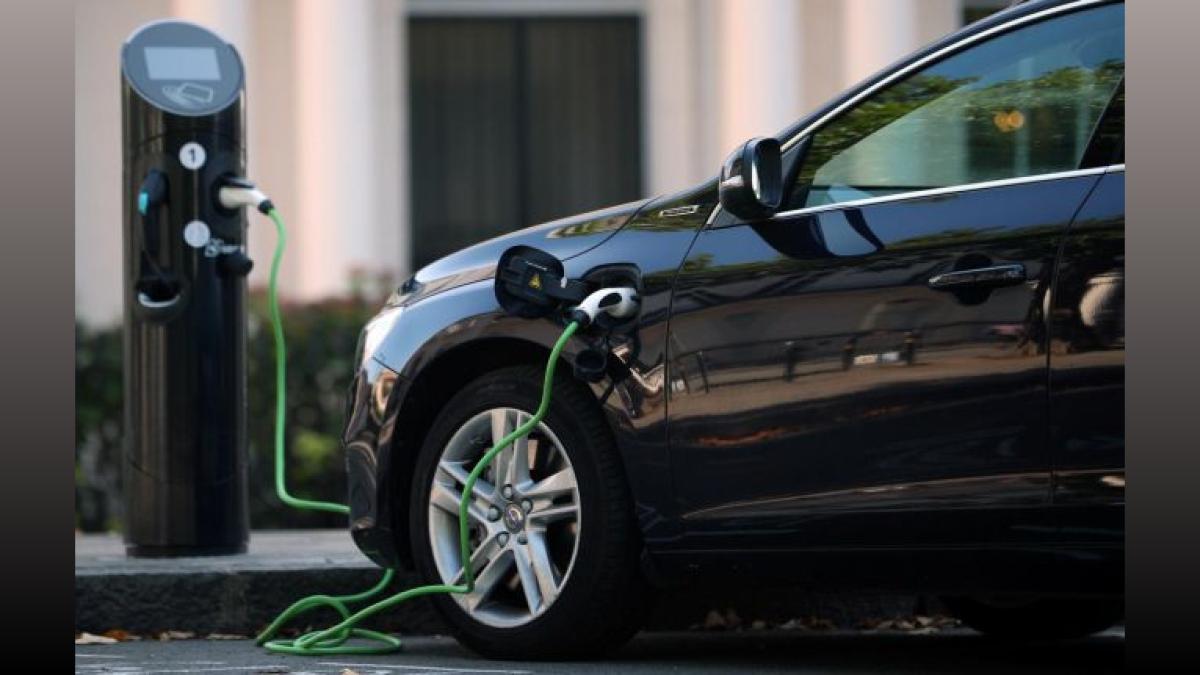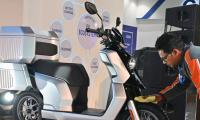Tech Transfer Pacts for NaMPET Innovations: Wireless EV Charger, Railway Propulsion
x
India's Ministry of Electronics and IT (MeitY) signs technology transfer and collaboration agreements for solutions developed under the National Mission on Power Electronics Technology (NaMPET), including an indigenous wireless EV charger and railway propulsion system.

New Delhi, Apr 7 (PTI) Ministry of Electronics and IT (MeitY) Secretary S Krishnan on Monday presided over signing of technology transfer and collaboration pacts for solutions developed under the National Mission on Power Electronics Technology (NaMPET), including one involving an indigenous wireless charger for electric vehicles.
An indigenous wireless charger for electric vehicles with the ability to charge 90 per cent battery in three hours will become a reality, with CDAC and VNIT Nagpur's technology passed on to Indian firm Global Business Solution to commercially develop it, an official release said.
"It is capable of operating on a 230V, 50Hz AC single-phase supply and charges a 4.8kWh onboard battery pack at 48V with 30A current in approximately 3 hours, achieving a maximum efficiency of 89.4 per cent within a coil separation of 7.512.5 cm," the release said.
Meity has also joined hands with Railways to make an indigenous propulsion system of locomotives, boosting railway electrification and industry adoption.
"Collaboration through MoA signed between C-DAC, Chittaranjan Locomotive Works (CLW) and industry partners for the indigenisation of Indian Railway propulsion system: The collaboration marks a transformative step in India's rail electrification efforts by developing an indigenous propulsion system for 3-phase electric locomotives with the Indian Railways aiming for full electrification by 2030," the release added.
The industries undertaking the pact were Daulat Ram Engineering Services Pvt Ltd (Bhopal), JMV LPS Ltd (Noida), and Electro-waves Electronics (HP), the release said, adding this "demonstrates the strong industry-academia-government synergy driving this initiative".
"These partners will play a crucial role in testing, product engineering, and prototype deployment, ensuring successful field validation by Indian Railways, ensuring structured industry adoption and commercial rollout," the release added.
An agreement was also signed between C-DAC and Kerala Development and Innovation Strategic Council (K-DISC) for the deployment of green and sustainable grid solutions.
"The 48V Low Voltage Direct Current (LVDC) system, developed by C-DAC under the NaMPET programme with the support of MeitY, has emerged as a game-changing technology for energy conservation, green energy integration, and cost-effective power distribution," it said.
Kerala Development and Innovation Strategic Council (K-DISC) has implemented this system at its headquarters, making it the first administrative building in Kerala to be powered by 48V DC that could lead to 2030 per cent energy savings, contributing to Kerala's Carbon Neutrality Roadmap 2050 and India's broader Net Zero 2070 vision.
Speaking on the occasion, MeitY secretary stressed indigenisation in power electronics to boost Make in India' and Aatmanirbhar Bharat' goals.
The NaMPET is a mission-mode programme of IT Ministry involving research, development, deployment, demonstration, and commercialisation of technologies in the Power Electronics (PE) domain.
The programme is being implemented by the Centre for Development of Advanced Computing (C-DAC), Thiruvananthapuram, as the nodal agency with participating agencies from academia, R&D organisations, and industries.
The main focus areas of the programme include microgrid for powering remote villages, green energy for community buildings, empowerment of e-mobility ecosystem, smart power quality centre in the distribution grid, high voltage power electronics for food processing, agriculture, industry, and health, technology marketing, and promotion of start-ups with the platform for technology outreach.
An indigenous wireless charger for electric vehicles with the ability to charge 90 per cent battery in three hours will become a reality, with CDAC and VNIT Nagpur's technology passed on to Indian firm Global Business Solution to commercially develop it, an official release said.
"It is capable of operating on a 230V, 50Hz AC single-phase supply and charges a 4.8kWh onboard battery pack at 48V with 30A current in approximately 3 hours, achieving a maximum efficiency of 89.4 per cent within a coil separation of 7.512.5 cm," the release said.
Meity has also joined hands with Railways to make an indigenous propulsion system of locomotives, boosting railway electrification and industry adoption.
"Collaboration through MoA signed between C-DAC, Chittaranjan Locomotive Works (CLW) and industry partners for the indigenisation of Indian Railway propulsion system: The collaboration marks a transformative step in India's rail electrification efforts by developing an indigenous propulsion system for 3-phase electric locomotives with the Indian Railways aiming for full electrification by 2030," the release added.
The industries undertaking the pact were Daulat Ram Engineering Services Pvt Ltd (Bhopal), JMV LPS Ltd (Noida), and Electro-waves Electronics (HP), the release said, adding this "demonstrates the strong industry-academia-government synergy driving this initiative".
"These partners will play a crucial role in testing, product engineering, and prototype deployment, ensuring successful field validation by Indian Railways, ensuring structured industry adoption and commercial rollout," the release added.
An agreement was also signed between C-DAC and Kerala Development and Innovation Strategic Council (K-DISC) for the deployment of green and sustainable grid solutions.
"The 48V Low Voltage Direct Current (LVDC) system, developed by C-DAC under the NaMPET programme with the support of MeitY, has emerged as a game-changing technology for energy conservation, green energy integration, and cost-effective power distribution," it said.
Kerala Development and Innovation Strategic Council (K-DISC) has implemented this system at its headquarters, making it the first administrative building in Kerala to be powered by 48V DC that could lead to 2030 per cent energy savings, contributing to Kerala's Carbon Neutrality Roadmap 2050 and India's broader Net Zero 2070 vision.
Speaking on the occasion, MeitY secretary stressed indigenisation in power electronics to boost Make in India' and Aatmanirbhar Bharat' goals.
The NaMPET is a mission-mode programme of IT Ministry involving research, development, deployment, demonstration, and commercialisation of technologies in the Power Electronics (PE) domain.
The programme is being implemented by the Centre for Development of Advanced Computing (C-DAC), Thiruvananthapuram, as the nodal agency with participating agencies from academia, R&D organisations, and industries.
The main focus areas of the programme include microgrid for powering remote villages, green energy for community buildings, empowerment of e-mobility ecosystem, smart power quality centre in the distribution grid, high voltage power electronics for food processing, agriculture, industry, and health, technology marketing, and promotion of start-ups with the platform for technology outreach.
You May Like To Read
TODAY'S MOST TRADED COMPANIES
- Company Name
- Price
- Volume
- Vodafone-Idea-L
- 11.65 (+ 3.56)
- 106772451
- Alstone-Textiles
- 0.28 ( -3.45)
- 44187760
- Mangalam-Industrial
- 0.88 ( -2.22)
- 39177573
- Sunshine-Capital
- 0.27 (+ 3.85)
- 35956340
- GMR-Airports
- 104.40 (+ 6.37)
- 30453005





